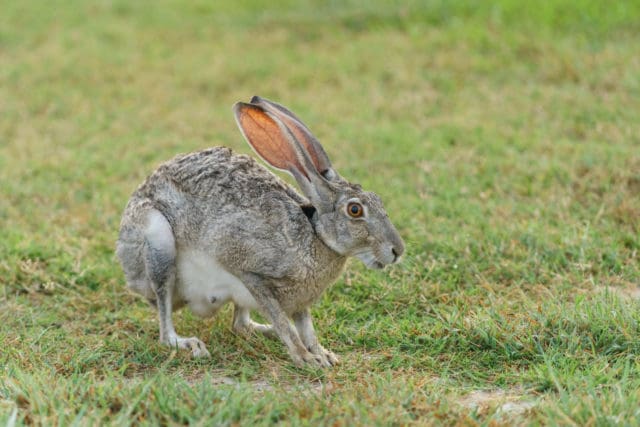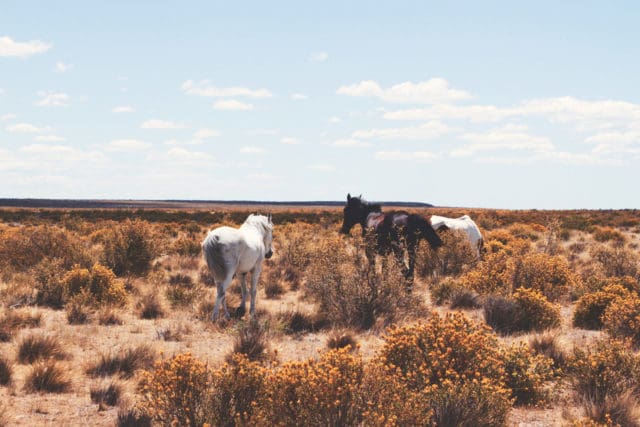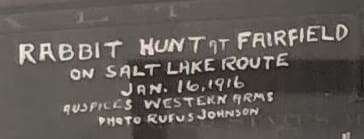In 2016 the rabbit population in Eagle Mountain exploded. Eagle Mountain Blvd was called by some as “slaughter road” because of the number of rabbits that were hit and killed nightly. During January 2016 the Eagle Mountain Citizens Facebook page had several people ask about the number of rabbits that were killed on the side of the road.
“Anyone know why the rabbits are committing suicide in droves down in city center? It’s sad… And pretty gross” – Shellece Gruber 1/12/2016.
“Why are there so many dead rabbits in city center on the main road” Christy Jamie Delaplaine – 1/12/2016.
I live on a somewhat isolated dirt road in Eagle Mountain and we would constantly see them running across the road while heading to or from home. That same year, we lost several of our fruit trees to rabbits eating the bark off of them during the winter. The rabbit population reaches the top of its cycle about every ten years. If that cycle stays true, the next big one should hit Eagle Mountain in 2026. The Utah Division of Wildlife Resources discussed the rabbit cycle in 2017, “The number of cottontail rabbits in Utah has dropped a bit from last year.” Referring to what residents noticed in 2016. Wildlife Resources continue, “But rabbit numbers are still at the top of a 10-year population peak.” “Cottontail rabbits experience a 10-year population cycle: after topping out, the population declines for about five years. Then, after bottoming out, the number of rabbits starts climbing again. Right now, the rabbit population in Utah is at the top of the cycle.” This was written back in 2017, but if we take a look in to the past, we see that the rabbit population has been a problem for pre-Eagle Mountain and Cedar Fort residents.

The book “Our roots Grow Deep – A History of Ceder Valley” discusses rabbits in the Cedar Valley area. “Sometimes a group would go with shotguns on a drive to shoot rabbits. They would form a line with hunters about fifty yards apart. They then would walk several miles through the sage brush to herd the rabbits, which would attempt to sneak behind the hunters. They were nearly the same color as the brush, and by moving slowly, sometimes they could escape. If the rabbits knew they had been seen, they would usually run ahead of the line of men, moving back and forth, or maybe straight back in an effort to get away. Most hunters had good eyes, and it didn’t take long for them to obtain the meat they needed. Sometimes trucks would be used to chase rabbits. In the winter time, horses were often used to hunt, as they could travel well on the snow, and it was a handicap to the rabbits as everyone of their tracks could be easily seen. Most often New Years was celebrated with a hunt.”
It was also reported that the large number of rabbits would cause issues for feeding live stock. Joseph Person hacking for Cedar Fort (born 1874) told a relative about this problem. “Also another year their fields and crops were being doomed by an infection of the big Jack Rabbit. The farmers built tight fenced corrals and drove the Jack Rabbits into the enclosure…”
In 1914, which could of easily been at the top of one of those 10-year population cycles, there was a rabbit hunt conducted in the Cedar Valley, and other Utah County areas in December.
The Lehi Banner on December 12, 1914 reported on this hunt.
.. the greatest rabbit hunt in Utah county’s history will take place in Cedar Valley tomorrow, December 13. It looks now as if there would be between 500 and 600 hunters to take part in the slaughter. Three hundred members of the Salt Lake Gun club will come down by special train from Salt Lake City, and will be met at Fairfield by thirty teams from Fairfield and Cedar Fort, who will take the Salt Lakers to State well, and south end of the rabbit infested district.
Between 200 and 300 hunters from Utah county will commence shooting the long eared bunnies at the divide where the road crosses the valley to the way from Lehi to Fairfield.
…The men will form a semi-circle at each end and come together some place in the neighborhood of the sinks, southeast of Fairfield. In this way it is hopped to encircle and slaughter a good many thousand rabbits.
The American Fork Citizen reported in December 19, 1914 about the Cedar Valley Hunt. “The big rabbit hunt in Cedar Valley last Sunday, planned by the Salt Lake parties, was successful in a way, but not more than a tithing of the bunnies in the valley were killed, it is estimated that between 3000 or 4000 rabbits were killed.” The rabbit problem was so bad that the American Citizen reported that additional hunts are being planned. The Utah County government also got involved. The American Fork Citizen continues, “The county commissioners have signified a willingness to pass a bounty of probably 3 cents on each rabbit killed, and an ordinance providing for the bounty will probably be passed at the commissioner’s meeting Monday.”

During December 7, 1914 Utah County Commissioners meeting the rabbit situation was discussed by the County Commissioners. “Petition from the residents of Cedar Valley and Pleasant Grove for bounty for the destruction of ground squirrels, jack rabbits etc., taken under advisement.” The minutes continue, “Petition from the residents of Mosida asking for a bounty on certain animals hereby taken under advisement.” It should be noted, that there is no record of an ordinance or an official bounty being passed at that time, as eluded to by the American Fork Citizen article.
An additional hunt was arranged in the Eureka area the next week, they used money from the hunt to hold a dance in the area, and pay for train transportation to the hunt. The Eureka Reporter on December 18, 1914 reported about the hunt.
“Everything is now ready for the big rabbit hunt which will be pulled off near Adams switch on the Salt Lake Route next Sunday. That it will be the biggest event of the year goes without saying.
The money has been put up for the special train which will take the shooters to the rabbit ground. Teams have been secured to haul the rabbits back to the train. The county commissioners have agreed to allow the usual bounty on the slaughtered jacks and there is absolutely no reason why the hunt will not be the most successful ever pulled off here in Tintic.
…
By having a box car to haul the rabbits it will be possible to keep all of them for proper distribution. They will not be dumped out on the ground and carried away by a few hoggish individuals as they have been at previous hunts. On the contrary the box car will be locked until the committee can take charge of the distribution the following day and an effort will be made to deliver the rabbits to people who will most appreciate them.”

The Eureka Reporter also reported on what happened after the hunt in their area. On December 25, 1914 they reported, “Tintic sportsmen took part in a very successful rabbit hunt last Sunday.” It continues, More than a hundred tickets were sold and a bunch of scatter gun artists who made the trip killed in the neighborhood of 2000 rabbits at about 1300 were picked up and brought back to Eureka.” “The rabbits were kept locked up in a freight car until the following morning when they were distributed under the direction of Sheriff Ben Rod Marshal Allen and Charlie Baker. Some of the stores donated their delivery outfits which enabled the committee to spend the rabbits to people who appreciated them.”
The issue was lessened, but in 1916 on December 16th the issue was brought up again before the Utah County Commission. The minutes for the December 18, 1916 commissioner meeting includes references to the problem as well. “Clyde, Lindsay, of the Farm Bureau and other asked that County help to destroy rabbits in Cedar Valley.” On a related note, there were also some reference in 1911 for the authorization of strychnine for fighting squirrels in American Fork. The May 15, 1911 commission meeting minutes included, “County Clerk is authorized to send $5.00 worth of strychnine to J.H. Gardner and the same amount to S.L Chipman of American Fork for the destruction of ground squirrels.
It will be interesting to see what happens to the rabbit population over the next few years as the cycle heads back to the top. With the Facebook Datacenter, Sunset Flats, and Overland subdivisions, the problem will not hit the scale it did back 1914, but it will continue to be an issue in the undeveloped areas of what is now Eagle Mountain.
Update 8/19/2019

I was contacted by Vic Bachman via the contact form on this site. He works for an HVAC company in Northern Utah. While he was at a clients house doing some work, he found a photo hanging on their wall. He took a picture of the photo and then contacted me when he stumbled on the this article. I am in the process of getting more information, but here is photography of the photo that was hanging on his clients wall.
The photo is labeled “Rabbit Hunt at Fairfield on Salt Lake Route. Jan. 16, 1916… Photo Rufus Johnson”
Additional Resources
Plenty of rabbits and hares – August 25, 2017 (DNR)
Upland game hunts look promising – August 19, 2016
American Fork Citizen, December 19, 1914
Mike Kieffer – Editor-in-Chief, Cedar Valley Sentinel
Mike Kieffer is a dynamic leader and community advocate based in Eagle Mountain, Utah. He serves as the Editor-in-Chief of the Cedar Valley Sentinel, a local publication dedicated to informing, inspiring, and elevating the Cedar Valley community through honest and accurate journalism. With a passion for fostering connections, Kieffer has made it his mission to highlight local businesses, provide reliable news, and support community development.
Beyond his editorial role, Kieffer is the owner of Lake Mountain Media, LLC, a company specializing in media and communications, and the co-owner of Quail Run Farms, which focuses on sustainable farming and community engagement. He also actively contributes to the local economy and culture as a member of the Eagle Mountain Chamber of Commerce.
Kieffer’s dedication extends to preserving and promoting the history and heritage of the Cedar Valley area. He often participates in community-centered events and media, including podcasts that explore the unique aspects of life in the region. Through his varied endeavors, he remains a steadfast advocate for the growth and enrichment of the local community.



